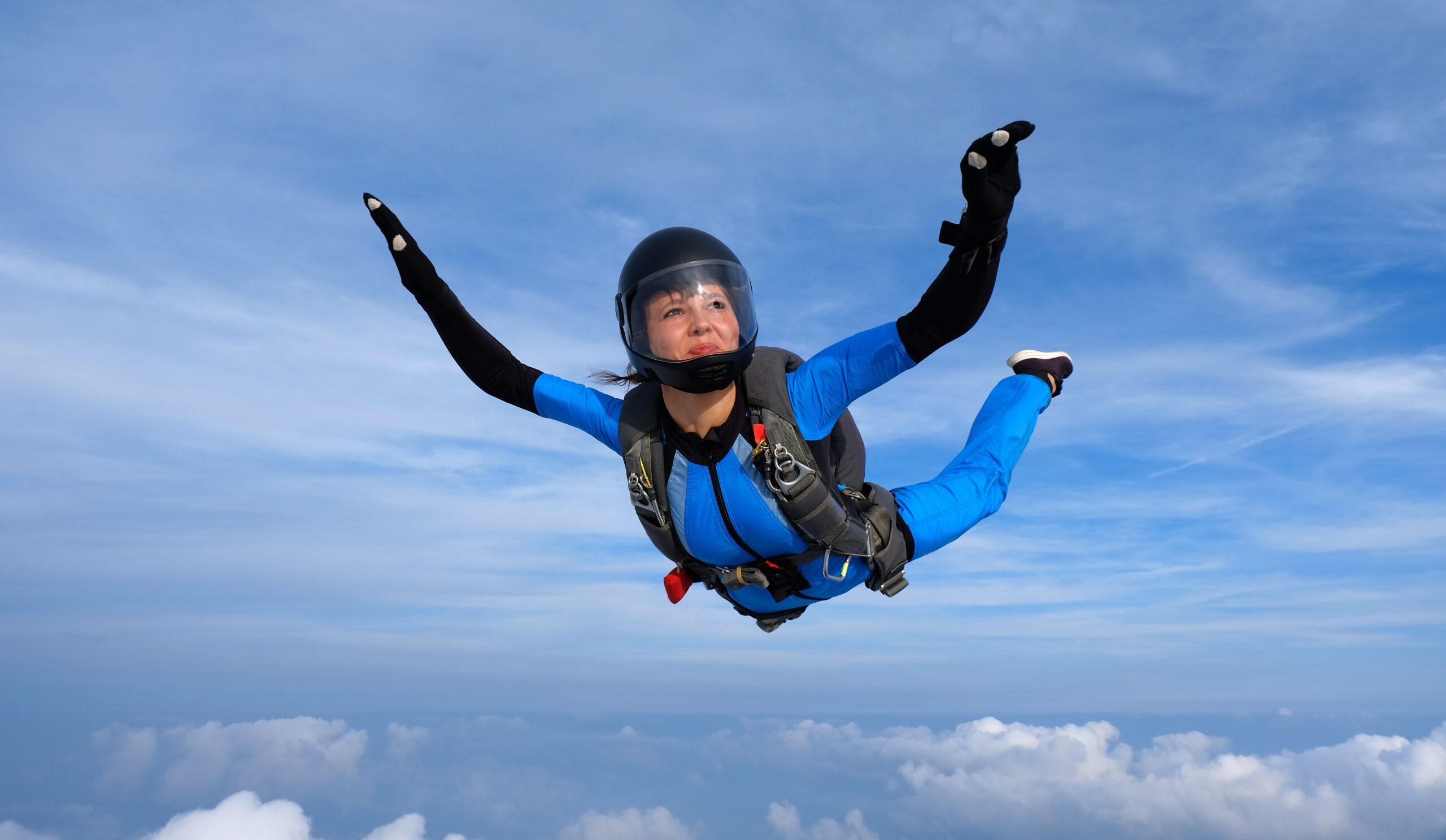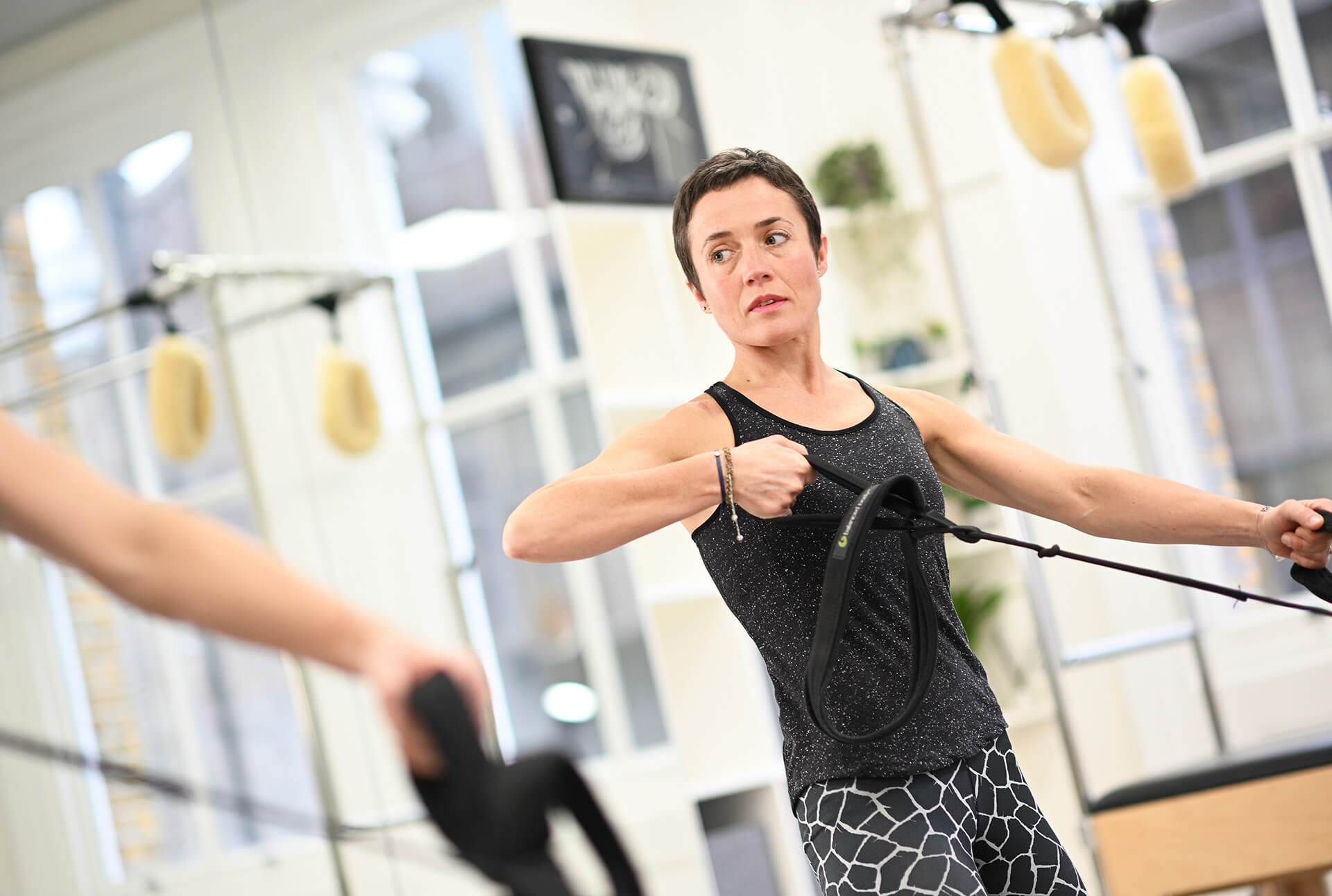Author: Alex Wachter is a Polestar certified Pilates Instructor and osteopath-in-training.
Ever wanted to skydive? Thinking about learning to skydive or just starting out? Are you a professional skydiver?
Whatever level you are, Pilates can help you feel comfortable, safe, strong and confident when you are in the air and jumping out of that plane!
In this article, we’ll discuss: what the skydiving position is, what you need to be able to do to hold the skydiving position and how Pilates can help improve your skydiving
Pilates for skydiving: what is the skydiving position?
The skydiving position, known as The Arch, is when you have your belly pointed down to the ground, arms bent out to the side and your chin tucked under. Sounds simple right? But it still requires a lot of different body components and awareness.
It’s one thing to hold the Arch, but you also need to have the strength and mobility in your arms and legs to aid in controlling your movements in the sky (not spinning out of control!) and maintain stability!
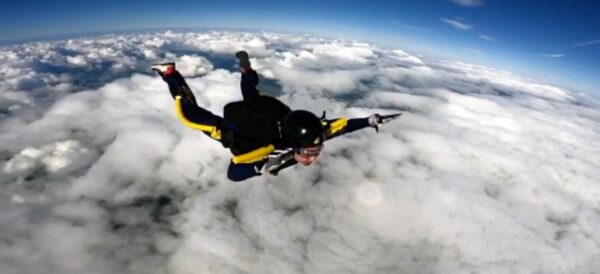
The Arch position your body needs to adopt and maintain when skydiving is not our usual everyday posture, so it can be hard to figure out where your body is in space, particularly when you’re 15,000 feet off the ground. So, where do you start?
Pilates for skydiving: how can Pilates help you?
This is where Pilates, particularly equipment Pilates, can really help you. Pilates is amazing at not only increasing your strength, but also your mobility and stability and helping you work out where you are in space!
Everyone’s starting level is different. This means what you are naturally able to achieve will be different for each person. When you come into the studio, we go through a full assessment and provide you with tailored goals and timelines. This assessment includes an analysis of your posture where we observe your postural pattern and identify any asymmetrical differences. Movement analysis is where we look at how you move, what your range is, and what your current strength and flexibility is.
But it’s not all about posture and movement, a key part of the assessment is understanding YOU as a person. What are your goals? What is your history of injuries, accidents, and exercise? What is important to you and how do you like to work?
It’s important for you to know that there is no right or wrong answer to anything we ask. The more we know about you, the better we can help you achieve your goals. As with any clinical setting, our studio is a safe space so anything that you say is completely confidential.


Pilates for skydiving: how to perfect the Arch position
Once we know what you can do and what you struggle with, we can look at where to start. Typically, the first element to work on is how to perfect the Arch position.
To hold the Arch position, you will require:
- core strength
- back flexibility
- full shoulder range of movement
- arm strength
- good hip flexor length
- strong glutes and back
- And if that isn’t enough, the ability to know what each part of your body is doing in space simultaneously.
In between your Pilates sessions, we recommend you book some wind tunnel sessions as well so you can track your progress and take what you’ve learnt from the studio into an alternative environment.
Depending on your skydiving training provider and how often you can attend Pilates each week you may also be doing jumps in between. Be sure to get your videos and bring them into the studio so we can see how you’re doing up there.
Pilates for skydiving: how Pilates can help with your landing
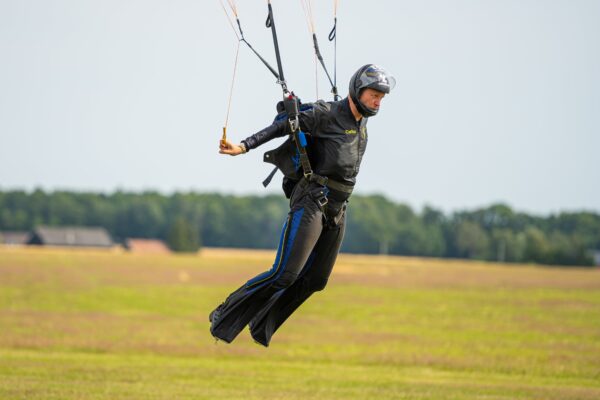
After the Arch, we come to the landing.
Here we start to focus on your upper body strength to ensure you have the power to not only pull the parachute but also control your descent and navigate your way to land in the right drop zone. Remember, depending on your body weight you may also have extra weights strapped to you when you descend to increase your ‘terminal velocity’.
Related Reading: Pilates Shoulder Exercises
Terminal velocity by sky diving definition is the top speed a person can achieve when they fall through the air – the considered average speed is around 120mph. Gravity is a constant force; however terminal velocity can be manipulated by a few things, including weight, density and shape.
Changing your weight and density is not really within the scope of Pilates training, however, shape most certainly is. Whilst you’re falling from the sky you need to be able to manipulate your body into a position which allows you to maintain a constant speed and an even drag but then hold it there for stability when required.
Consequently, a combination of isometric and isotonic exercises are needed. Isometric exercises will help to increase strength and endurance by engaging the muscles without movement (for example – holding your arms overhead in the arch position), while isotonic exercises rely on consistent resistance through a full range of motion to build strength (for example moving the arms to manipulate movements in the air and handle the parachute pulleys).
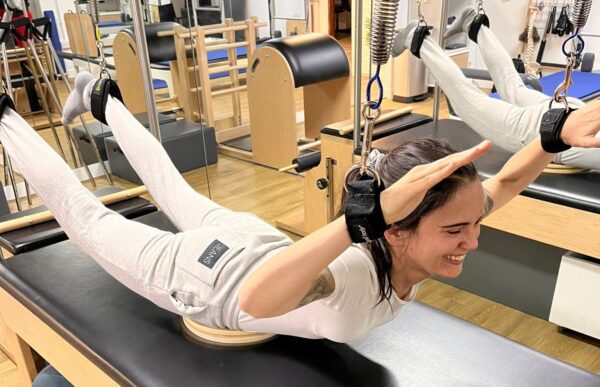
Your upper body plays a key role in how you land and how you move through the air. At all times, whether it be in the arch position or controlling the parachute as you descend your arms are positioned overhead, unless pulling the parachute down in the final stage of the skydiver flare, thus you need bulletproof strength in your shoulders along with precise muscle recruitment in order to adduct and internal rotate the shoulder and then abduct and externally rotate the shoulder. These are the key movements we focus on to improve muscle patterning.
Muscles cannot work efficiently if we do not have good patterning. Muscle patterning refers to the co-ordination and activity of muscles around a particular joint. If one muscle isn’t working efficiently, then it will affect all the surrounding tissues and beyond, and other muscles will often try to compensate.
For example, if your deltoid or supraspinatus muscles (these are responsible for abducting the arm from 0-90 degrees) are not functioning correctly, then other muscles such as the trapezius and serratus anterior need to pick up the slack and they may do a poor job or be forced to overwork.
Here in the studio, we can manipulate various aspects of an exercise to change the focus depending on the imbalances found in your assessment, such as changing the tension, surface and the angle.
Your progress is monitored by a few markers; with the arch, it’s seeing an increase in your range and the ability to hold your position for a certain time frame without losing form, incurring pain or fatiguing quickly.
With your upper body strength, we are looking to increase the force applied either by adding weights or changing spring tension, angles or a combination of both, and increasing the time under tension.
Once you’ve completed more jumps and progressed through the different levels of skydiving, we start to look at the finer body movements which allow you to turn in space and flip.
Pilates for skydiving: how can Pilates help improve your skydiving technique?
Breathing
In Pilates, we focus a lot on the breath. We know from lots of research that appropriate breathing patterns help you to move more effectively, calm your nervous system, increase your focus, and reduce tension.
When you are free falling, your adrenaline is pumping to help you act quicker – this is why it is commonly known as the ‘adrenaline rush’. It makes your heartbeat faster, increases blood flow to the brain and muscles, and because we require more energy our body makes more glucose (sugar) for fuel. This whole process is your sympathetic nervous system helping our bodies to respond to a stressful event appropriately – it’s our evolutionary survival mechanism and very necessary!
Let’s face it, we’ve got to where we are today because of evolution adapting and enabling our involuntary system to react quicker than we can ever rationally think. Have you ever jumped out of the way of a car well before you’ve computed what you are doing? Or pulled back your hand from something hot without thinking until after? Thank your sympathetic nervous system for that!
However, we don’t want this to happen after we’ve made the decision to do something which we would normally appraise as life or death, like jumping out of a plane. Instead, we need our parasympathetic nervous system to kick in to equalise that adrenaline rush. You’ve already jumped, so now it’s about making conscious decisions to ensure you maintain control!
Your parasympathetic nervous system is also autonomic which means you can’t consciously turn it on or off, but with breathing, you can definitely influence it.
The vagus nerve is the main nerve of the parasympathetic nervous system and when we make a conscious effort to breathe deeply it stimulates the vagus nerve, therefore promoting the response of the parasympathetic and slowing your heart rate, helping you to calm down.
Try this at home. Take 6 breaths in and out over the course of one minute. Breathe in deeply through you nose, allowing your stomach to expand upwards and outward like buddha before exhaling slowly and fully, still through your nose. Now try it whilst you complete an exercise.
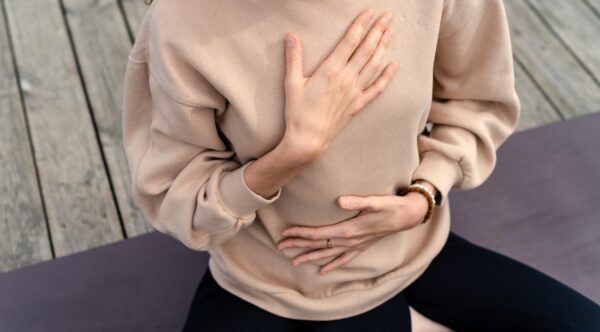
This is a key exercise you are going to want to remember and deploy when you’re falling through the air. When you’re calmer you can think more clearly and enjoy the experience. When we have clarity of mind we are more in tune with our bodies, allowing us to make the right decisions and enjoy the experience.
Posture
Pilates is a whole-body, holistic approach to movement and can help you to improve strength, balance muscle development, improve flexibility and increase your range. All very handy to achieve that Arch!
In reality, most of us struggle with posture.
Do you sit at a desk all day and know when you are slouching or do you occasionally catch yourself and try to sit up straight?
Knowing where your body is in space is a big part of improving your posture, which is why Pilates is so useful. If you are slouched and hunched over, your chest and rib cage will be in a less favourable position to breathe properly and fill up your lungs. Conversely, breathing can also help with posture encouraging you to sit taller and open your chest.
Pilates equipment can provide support and assistance
The springs, heights, tensions and variety of surfaces offered by the Pilates equipment gives you a multitude of options including whether you need assistance, challenge or some kind of physical feedback.
The curve of the ladder barrel can give you the support and feedback your spine needs to extend over and achieve the ‘Arch’ position. The springs on the reformer and trapeze table can act as the force you need to work against to mimic wind pressures. They also help you to work eccentrically which is what you need to control deceleration.
The rotational discs (as you can see below being used as an additional prop on the trapeze table) can be used to provide an extra force to work against to improve core strength and balance by resisting rotation. The overhead bars on the trapeze table can be used to work on strength when hanging to provide an activity off-ground level against gravity.
As you can see, the Pilates equipment can assist you in your movement and help you achieve not only the arch, but control, calmness of mind and the strength to land!
Pilates is adaptable
Make Pilates a regular part of your weekly activities and you’ll start to recognise how some of the movements we do in the studio not only translate into your skydiving but also into everyday life and the rest of your sporting activities.
Pilates doesn’t always have to be at a slow tempo or just counting repetitions; we can adapt exercises to create a little more power or endurance by changing the tempo or working to a time during an exercise. Strength + speed = power so if you want to build that you need to add load and also move with speed!
Why not try this endurance exercise at home? Take a Pilates exercise such as swimming, hold your position in your maximum range, where you can maintain good alignment, then increase the speed at which you move the arms and legs. Keep going and then slow it down, still moving the arms and legs. Can you then speed it up again and keep moving? How does this feel?
Pilates exercises for skydiving
Here’s a typical example of an at-home exercise programme for our skydiving aficionados. This is a great example if you are going through sky diving training or skydive regularly and in need of some great maintenance exercises.
Hip flexor stretch
Chest lift
Criss Cross
Side lying shoulder rotation
Scarecrow
Swimming
Bridging on your toes
We would recommend incorporating extension-focused exercises a little more often to help counteract the flexed position that most of us sit in daily.
Want to learn more or improve your technique? Come ‘fly’ with us! You can book your sessions here.
Not ready yet? Talk to us instead.
Education is key:
These blogs are designed to give information to everyone, however, it is important to remember that everyone is different! If you have not seen one of our therapists and have any questions about injuries, what you have read or whether this may be useful to you, please just ask. We are more than happy to help anyone and point you in the right direction. Our biggest belief is that education is key. The more you understand about your injury, illness and movement, the more you are likely to improve.


